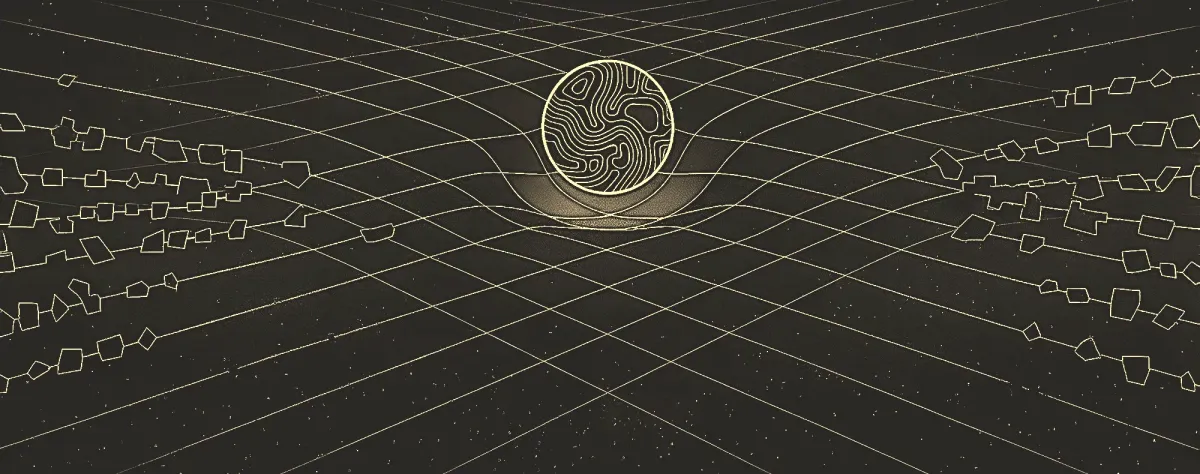Gravity's Ghost: The Force That Haunts Physics
We all know what gravity does. But physicists have a dark secret: on a fundamental level, they have no idea what it is


Of all the forces in the universe, gravity feels like an old friend. It’s the quiet, constant presence that keeps our feet on the ground and holds our world together. It’s so familiar that we barely notice it.
And that’s what makes it the most troublesome and mysterious force in all of physics.
Science has a beautiful family portrait of four fundamental forces that run our universe: the Electromagnetic force that powers our technology; the Strong Nuclear force that binds the heart of atoms; and the Weak Nuclear force that fuels the sun. They all get along, governed by a single, coherent set of rules.
And then there's gravity. The quiet friend. The one that refuses to play by the same rules. The one that breaks the family portrait. To understand why, we need to see that our universe is living a double life.
𒋝 Two Worlds, Two Rulebooks
Our universe is split into two vastly different domains. There is the world of the ‘bigs’ — planets, stars, and galaxies. This is a world that, from our perspective, feels certain, smooth, and continuous, like a flowing river.
But this world is built from the world of the ‘smalls’ — atoms, electrons, and quarks. This quantum realm is the polar opposite. It doesn't speak in certainties; it speaks the language of probabilities, fields, and pixelated, discrete jumps. It's a world of buzzing, unpredictable energy.
Common sense tells us that the rules for the ‘smalls’ must somehow add up to create the rules for the ‘bigs’. After all, a star is just a giant collection of atoms. This is where every other force behaves. But not gravity. Gravity has two different, contradictory rulebooks.
Rulebook #1: Einstein's Elegant Universe
For the world of the ‘bigs’, we use Albert Einstein's General Relativity. In this vision, gravity isn't a force in the traditional sense. It's the result of mass and energy warping the very fabric of spacetime. Imagine placing a bowling ball on a trampoline. The fabric sinks, and a marble rolled nearby will curve towards it. That elegant curvature is what we feel as gravity. The key words here are smooth, continuous, and dynamic. Spacetime is an active player.
Rulebook #2: The Fixed Quantum Arena
For the world of the ‘smalls’, we use Quantum Mechanics. In this world, forces are traditional forces. They are communicated by shooting tiny, discrete packets of energy — particles called quanta — back and forth. The electromagnetic force has the photon, for example. These interactions all happen on a fixed, passive background. Spacetime here is not a trampoline; it's a rigid, unchanging stage where the quantum drama unfolds. The key words are discrete, probabilistic, and fixed.
𒋝 The Collision
Do you see the problem? The two rulebooks are in complete opposition.
- Relativity says spacetime is dynamic and curved. Quantum mechanics needs it to be fixed and flat.
- Relativity says gravity is smooth geometry. Quantum mechanics says forces should be communicated by discrete particles (a hypothetical "graviton").
Logically, they can't both be right. And yet, experimentally, they both are. We've tested them countless times in their respective domains, and they are two of the most successful theories in human history.
This is the crisis. To try and solve it, physicists did the obvious thing: they took the quantum rulebook and tried to apply it to gravity. They tried to describe gravity as the exchange of these tiny "gravitons." The result was a complete disaster. The mathematics broke down, spewing out nonsensical infinities. It was like trying to zoom in on a perfectly smooth painting and finding that up close, it’s an infinitely chaotic mess of pixels that don't add up.
The world of the ‘smalls’ simply refuses to produce the world of the ‘bigs’ when it comes to gravity. And yet, here we are, living in a universe where the two exist side-by-side, one built on top of the other.
This is the great challenge of modern physics: to find a single theory — a unified vision — that can bridge this impossible gap. For the last 40 years, two main contenders have taken up the challenge: String Theory and Loop Quantum Gravity. Neither has succeeded.
In the coming articles, we'll explore why these grand attempts are failing. And I'll begin to share how a completely new perspective — the one I am working on — might finally resolve the dilemma of gravity, once and for all.
